How Cold Exposure May Help Regulate MS-Related Mood Swings
Introduction
Living with multiple sclerosis (MS) often means navigating a rollercoaster of unpredictable symptoms—not just physical, but emotional too. One of the lesser-discussed yet deeply impactful challenges is mood swings. For many people with MS, fluctuations in mood can come out of nowhere—ranging from sudden irritability or anxiety to unexpected tears or deep emotional lows.
But what if there were a natural, accessible way to help regulate those shifts? Enter cold exposure therapy.
From plunging into icy baths to stepping into a cold shower, cold exposure has gained attention in recent years for its mood-regulating, anti-inflammatory, and nervous-system-balancing effects. While it’s not a cure, emerging science suggests that cold exposure may offer real benefits for people with MS struggling with emotional volatility.
Let’s explore the relationship between cold exposure and MS-related mood swings—what the science says, how to try it safely, and what to expect.
Want a cold plunge? Click here.
🧠 Understanding Mood Swings in MS

Before diving into cold therapy, it’s important to understand why mood swings happen in MS in the first place.
1. Neurological Causes
MS is a central nervous system disease, meaning it affects the brain and spinal cord. When lesions form in regions of the brain responsible for mood regulation—such as the prefrontal cortex, amygdala, or hippocampus—it can disrupt normal emotional processing. This isn’t “just depression” or “anxiety” in the typical sense; it’s neuroinflammation interfering with emotional control.
2. Immune Dysregulation and Cytokines
Mood regulation is also impacted by immune system messengers called cytokines. In MS, elevated levels of pro-inflammatory cytokines like IL-6, TNF-alpha, and IFN-gamma have been linked to both depressive symptoms and heightened emotional sensitivity.
3. Fatigue and Stress
Chronic fatigue, sleep issues, pain, and mobility struggles can all chip away at emotional resilience. Add hormonal changes or heat sensitivity into the mix, and it’s easy to see how mood swings become part of the MS landscape.
🌊 What Is Cold Exposure Therapy?
Cold exposure therapy—also known as cold water immersion, cryotherapy, or simply cold plunging—involves deliberate exposure to cold temperatures, typically through:
- Cold showers (10–15°C)
- Ice baths or cold plunges
- Outdoor swims in natural bodies of cold water
- Whole-body cryotherapy chambers
The goal is not to suffer through discomfort, but to activate adaptive responses in the body—calming inflammation, training the nervous system, and releasing feel-good neurochemicals.
🔬 How Cold Exposure Affects Mood and the Nervous System

1. Stimulates the Vagus Nerve
Cold exposure—especially on the face, neck, or chest—stimulates the vagus nerve, which plays a key role in regulating the parasympathetic nervous system (your “rest and digest” state). Vagal activation helps:
- Calm the mind
- Lower heart rate and blood pressure
- Improve resilience to stress
- Reduce anxiety symptoms
For people with MS, who often experience autonomic nervous system dysregulation, this can be incredibly beneficial in stabilizing emotional ups and downs.
2. Releases Endorphins and Dopamine
Even short bursts of cold exposure can trigger a natural release of endorphins and dopamine—chemicals that boost mood, reduce pain, and promote mental clarity. A 2021 study found that dopamine levels rose by up to 250% after cold water immersion, with effects lasting for hours.
3. Reduces Inflammatory Cytokines
Cold therapy can lower levels of pro-inflammatory cytokines and increase anti-inflammatory markers like IL-10. Since inflammation plays a key role in MS mood symptoms, cooling the body could help reduce neuroinflammation and restore better emotional balance.
4. Increases Heart Rate Variability (HRV)
Heart Rate Variability is a measure of how well your nervous system adapts to stress. Cold plunging has been shown to increase HRV over time—a positive sign of nervous system resilience and mood regulation.
🌡️ How to Use Cold Exposure Safely with MS
⚠️ Important Precautions:
Before starting any cold exposure practice, talk to your neurologist, especially if you have cardiovascular issues, cold intolerance, or Raynaud’s phenomenon.
That said, most people with MS can try some form of cold therapy with adjustments.
✅ Beginner-Friendly Methods:
Face immersion: Fill a bowl with cold water and dip your face for 10–30 seconds. This stimulates the vagus nerve without full-body shock.
Cold shower finish: Start warm, then turn cold for the last 30–60 seconds. Work up to 2–3 minutes.
Hand and foot plunges: Dip extremities into cold water for 1–2 minutes to stimulate circulation and calm nerves.
Short cold plunge: If you're ready, try immersing in 10–15°C water for 1–3 minutes, then warm up gently.
🔁 Frequency:
Start 2–3 times per week.
Some people benefit from daily cold exposure (especially quick showers).
Listen to your body and increase gradually.
🧣 Always Warm Up After:
Use blankets, warm drinks, movement, or infrared saunas to restore core temperature and prevent chills post-session.
🧘 Real Benefits People with MS Report
From anecdotal evidence and MS support communities, cold therapy has helped people with MS to:
- Feel emotionally “reset” after a flare or stressful day
- Reduce anxiety or irritability spikes
- Calm overstimulation or sensory overload
- Improve mental clarity after foggy episodes
- Boost resilience to future stressors
Some even describe it as "a nervous system reboot" that helps them approach the day with more emotional control and energy.
🔁 How Cold Exposure Complements Other Mood Tools
Cold therapy doesn’t replace treatment but works best alongside other MS mood-stabilizing tools like:
Medication (for depression, anxiety, or mood regulation)
Therapy (CBT, DBT, or trauma-informed care). Click here to try Online therapy.
Mind-body practices (yoga, meditation, journaling)
Anti-inflammatory supplements (Omega-3s, magnesium, curcumin). Click here for supplements for people with MS.
Nervous system regulation (breathwork, vagus nerve toning). Click here to try breathwork.
When used consistently, cold exposure can be part of a layered, holistic approach to emotional resilience with MS.
🧩 When to Avoid Cold Exposure
While cold therapy is safe for many, some should avoid or modify it:
- People with cardiovascular disease
- Those with extreme heat/cold sensitivity
- People in the middle of a relapse unless cleared by their doctor
- Individuals with hypothyroidism, Raynaud’s, or nerve pain aggravated by cold
Start small, test your response, and never force yourself through panic or pain. The goal is nervous system balance, not shock.
💡 Final Thoughts: It’s About Regulation, Not Perfection

Mood swings in MS aren’t a sign of weakness. They’re a signal that your nervous system is under pressure—biochemically, emotionally, or neurologically.
Cold exposure won’t magically erase those mood shifts, but it can retrain your nervous system over time. With consistency, even just a few minutes of cold therapy per day can help you feel calmer, more grounded, and emotionally more stable.
In the end, the power lies in small, repeatable actions that build resilience—not just physically, but emotionally, too.
Want a cold plunge? Click here.
📌 Quick Tips to Get Started
| Habit | Description |
|---|---|
| 🧊 Cold face splash | Easiest way to start. Dip your face in ice water for 10–20 seconds. |
| 🚿 Contrast shower | Finish your warm shower with 1 minute cold. Gradually increase to 3 min. |
| 🛁 Cold plunge | 1–3 minutes in 10–15°C water. Have warm clothes ready after. |
| 📅 Track your mood | Use a journal or app to track mood before and after cold sessions. |
| 🤝 Pair with breathing | Practice box breathing (inhale 4, hold 4, exhale 4, hold 4) while cold. |
📚 References
Shevchuk, N. A. (2008). Adapted cold showers as a potential treatment for depression. Medical Hypotheses, 70(5), 995–1001.
van Tulleken, C. et al. (2014). Winter swimming improves general well-being. PLOS ONE.
Rymaszewska, J., Ramsey, D., & Chładzińska-Kiejna, S. (2008). Whole-body cryotherapy as adjunct treatment of depressive and anxiety disorders. Archives of Psychiatry and Psychotherapy, 1, 49–57.
Kox, M. et al. (2014). Voluntary activation of the sympathetic nervous system and attenuation of the innate immune response in humans. PNAS, 111(20), 7379–7384.
Tipton, M. J., et al. (2017). Cold water immersion: kill or cure?. Experimental Physiology, 102(11), 1335–1355.
Bretherton, B. et al. (2019). Vagus nerve stimulation for depression: A systematic review and meta-analysis. Psychological Medicine, 49(2), 265–276.
Mahbub, S. et al. (2021). Neuroimmune interactions and the role of cytokines in MS-related mood symptoms. Journal of Neuroinflammation, 18(1), 123.
Related Posts
-

Learning to Feel Safe in Your Body Again
If your body no longer feels like a safe place—due to trauma, chronic illness, or anxiety—you’re not alone. This guide offers gentle, body-based strategies to help you reconnect with yourself, regulate your nervous system, and rebuild trust in your physical experience.
-

When You Feel Emotionally Unlovable: Challenging the Lie
Feeling unlovable because of your emotions, illness, or sensitivity? You’re not broken—you’re healing. Learn how to challenge the lie of emotional unworthiness and rebuild self-trust, one compassionate step at a time.
-
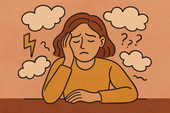
Brain Fog and Fatigue: How to Stop Blaming Yourself
Struggling with brain fog or chronic fatigue? You’re not lazy or failing. Learn how to stop blaming yourself for symptoms caused by MS or chronic illness, and start embracing a more compassionate path to healing and self-understanding.
-

Creating an Emotional Support Team You Actually Trust
Tired of feeling unsupported or misunderstood? Learn how to build an emotional support team you actually trust—with people who see you, hold space for you, and respect your boundaries, especially when living with MS or chronic illness.
-

MS, Vulnerability, and the Fear of Being Seen
Living with MS can make vulnerability feel unsafe. Learn why so many people with MS hide their struggles—and how to gently move toward authenticity, self-acceptance, and deeper connection without shame.
-
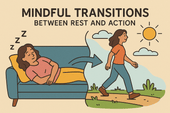
Mindful Transitions Between Rest and Action
Struggling to shift between rest and activity without guilt or overwhelm? This guide offers gentle, mindful strategies to make transitions feel more natural, intentional, and supportive of your nervous system.
-
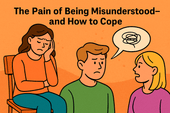
The Pain of Being Misunderstood—And How to Cope
Feeling the sting of being misunderstood? Learn why it hurts so deeply and discover practical, healing strategies to protect your truth, communicate clearly, and rebuild emotional safety when others just don’t get it.
-

Letting Go of Productivity Guilt When You Need to Rest
Struggling with guilt every time you try to rest? Learn how to release productivity shame, understand why rest matters, and embrace a more compassionate rhythm for healing and recovery—without feeling lazy.
-

Rebuilding Energy Reserves Without Shame
-

What to Do If You Feel Emotionally Invalidated by Doctors
Feeling emotionally invalidated by your doctor can be deeply distressing. Learn how to recognize medical gaslighting, validate your own experience, and advocate for better care when you’re not being heard.
-

How to Rest Without Feeling Lazy
Rest isn’t laziness—it’s a necessary act of self-respect. Learn how to shift your mindset, let go of guilt, and embrace rest as a vital part of mental and physical well-being.
-

Redefining Energy Management as Emotional Self-Care
Energy isn’t just physical—it’s emotional. Learn how redefining energy management as emotional self-care can help you protect your peace, support your nervous system, and live more in tune with your true needs.
-
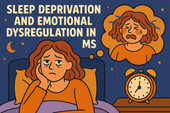
Sleep Deprivation and Emotional Dysregulation in MS
-
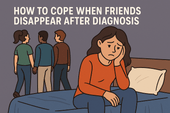
How to Cope When Friends Disappear After Diagnosis
Losing friends after a diagnosis can feel like another kind of grief. Discover why some friends disappear—and how to cope with the emotional fallout while building more supportive relationships.
-

How to Talk to Your Kids About MS Without Overwhelming Them
Struggling with how to explain MS to your kids? Learn how to talk to children of all ages about multiple sclerosis with honesty, clarity, and emotional safety—without overwhelming them.
-
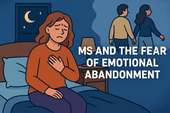
MS and the Fear of Emotional Abandonment
The fear of emotional abandonment is common for people with MS. This article explores why it happens, how it impacts your relationships, and how to create emotional safety and healing.
-

Forgiveness, Closure, and Letting Go of the Past with MS
Living with MS often brings emotional wounds from the past. Learn how forgiveness, closure, and letting go can help you heal emotionally—and reclaim peace in the present.
-
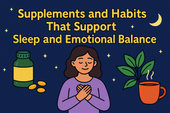
Supplements and Habits That Support Sleep and Emotional Balance
Struggling with poor sleep and emotional ups and downs? Discover calming supplements and daily habits that support deep rest and mental well-being—backed by science and easy to implement.
-
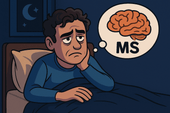
When Insomnia Feels Like Your MS Brain Won’t Turn Off
Struggling to sleep with MS? When your brain won’t shut off at night, insomnia feels relentless. Learn what causes it—and discover science-backed strategies to calm your mind and finally rest.
-

The Emotional Toll of Waking Up Tired Every Day: Why It Hurts More Than You Think
Waking up tired every day takes a deep emotional toll—from mood swings to lost motivation and self-doubt. Learn why chronic fatigue hurts more than you think and how to gently reclaim your mornings.
-
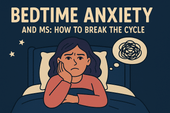
Bedtime Anxiety and MS: How to Break the Cycle
Bedtime anxiety is a common struggle for people with MS—and it’s more than just racing thoughts. Learn how MS-related stress, nervous system dysregulation, and fear of symptoms can create a cycle of sleeplessness, and discover practical, calming strategies to finally reclaim restful nights.
-
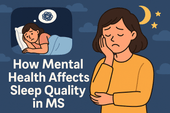
How Mental Health Affects Sleep Quality in MS: Breaking the Cycle of Fatigue and Emotional Distress
Struggling to sleep when you have MS? Discover how anxiety, depression, and neurological changes impact your rest—and what you can do to reclaim it. From CBT-I and calming supplements to lifestyle tips that support both mental health and sleep, this guide offers practical strategies for better nights.
-

Learning to Love Your Life (Even When It’s Not What You Expected)
Your life may not look how you imagined—but it’s still worth loving. Learn how to find peace, purpose, and joy in the unexpected.
-
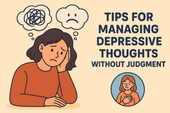
Tips for Managing Depressive Thoughts Without Judgment
Learn how to meet depressive thoughts with compassion, not shame. These gentle, research-backed tools help you manage low moods without self-judgment.
-

Rewiring Hope: How to Slowly Come Back to Life
Feeling emotionally numb or disconnected? Learn how to gently rebuild hope, one small sensory step and spark of life at a time.
-
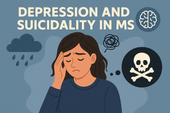
Depression and Suicidality in MS: A Conversation That Needs to Happen
Depression and suicidality in MS are real—and urgent. Learn why we must talk about it, how to spot warning signs, and where to find help and hope.
-

Finding Meaning When Life Feels Empty
Feeling disconnected or numb? Discover gentle ways to find meaning again—even in emptiness—through daily rituals, reflection, and purpose.
-
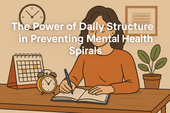
The Power of Daily Structure in Preventing Mental Health Spirals
Daily structure can prevent mental health spirals by creating safety, routine, and self-trust—especially for those with MS, depression, or anxiety.
-

Healing from Emotional Flatness with Sensory Rituals
Feeling emotionally numb or disconnected? Discover how sensory rituals can gently restore pleasure, presence, and emotional resilience.
-

The Role of Light Therapy for Seasonal Depression and MS
Can light therapy ease seasonal depression in people with MS? Discover the science, benefits, and how to use it safely for better mood and energy.
-

Medication vs Therapy: Treating MS-Related Depression Effectively
Explore whether therapy, medication, or both are best for treating MS-related depression. Understand what works, when—and why combination care is often ideal.
-

How to Support a Partner with MS and Depression
Learn how to support a partner living with MS and depression—practical tips, emotional tools, and ways to protect your own mental health too.
-

The Emotional Cost of Losing Your Old Life
Losing your old life to MS isn’t just about physical symptoms—it’s about grieving the identity, dreams, and freedom you once had. This article explores the emotional toll of invisible grief and how to begin healing without denying the pain.
-
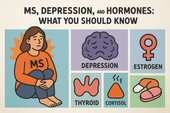
MS, Depression, and Hormones: What You Should Know
MS-related depression isn’t always just emotional—it can be hormonal. Discover how thyroid, sex, and stress hormones influence mood in MS, why women may feel worse during PMS or menopause, and what signs to look for when hormones may be driving emotional instability.
-

MS and Anhedonia: Reclaiming Pleasure One Step at a Time
Anhedonia—feeling emotionally flat or disconnected—is a common but misunderstood symptom of MS depression. This article explores how neuroinflammation, dopamine disruption, and fatigue can dull your sense of joy—and how small, gentle steps can help you begin to feel again.
-
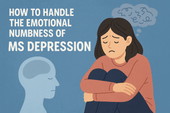
How to Handle the Emotional Numbness of MS Depression
Emotional numbness in MS depression doesn’t always look like sadness—it can feel like nothing at all. Learn why this disconnection happens, how it's tied to neuroinflammation and nervous system overload, and discover science-backed strategies to gently reconnect with your emotions.
-
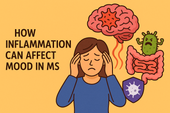
How Inflammation Can Affect Mood in MS
Mood swings and emotional numbness in MS aren’t just psychological—they can be driven by immune system inflammation. This article explores how inflammatory cytokines affect the brain, why mood changes are often biological, and what you can do to calm your nervous system from the inside out.
-
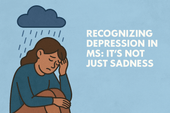
Recognizing Depression in MS: It's Not Just Sadness
Depression in multiple sclerosis (MS) is more than just sadness—it can be a neurological symptom, a side effect of inflammation, or a silent weight that masks itself as fatigue or emotional numbness. This article helps you recognize the hidden signs of MS-related depression, understand the science behind it, and explore real treatment options that support both mental and physical health.
-

Is Cryotherapy Safe for MS? Pros, Cons, and How It Compares to Cold Plunges
Cryotherapy promises quick recovery, inflammation reduction, and mood support—but is it safe for people with MS? This article breaks down the science, risks, and real-life benefits of cryotherapy for multiple sclerosis. You’ll also learn how it compares to cold plunges and which option may be better for calming flares and regulating your nervous system.
-

Can Cold Plunges Help Reduce Inflammatory Flares in MS?
Flares in multiple sclerosis (MS) are often driven by inflammation—but what if cold water could help turn down the heat? This in-depth article explores how cold plunges may help reduce flare frequency and intensity in MS by calming the immune system, lowering pro-inflammatory cytokines, and regulating the nervous system. Learn how to safely use cold exposure as part of your MS recovery routine.
-
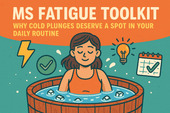
MS Fatigue Toolkit: Why Cold Plunges Deserve a Spot in Your Daily Routine
Fatigue is one of the most debilitating symptoms of multiple sclerosis (MS)—often invisible, misunderstood, and overwhelming. While no single tool can eliminate it, building a personalized fatigue management toolkit can make life more manageable. One surprising contender? Cold plunges. In this article, we explore why cold water immersion might be the refresh button your nervous system needs—and how to safely make it part of your MS fatigue routine.
-
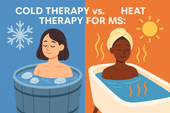
Cold Therapy vs. Heat Therapy for MS: Which One Helps More?
Managing multiple sclerosis (MS) often means navigating symptoms like fatigue, spasticity, pain, and nerve dysfunction. But when it comes to using temperature-based therapies, there’s a question many patients face: Should I be using cold or heat? In this in-depth guide, we explore the benefits, risks, and best use cases of cold therapy vs. heat therapy for MS.
-
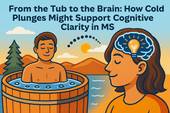
From the Tub to the Brain: How Cold Plunges Might Support Cognitive Clarity in MS
Cognitive fog is one of the most frustrating symptoms of multiple sclerosis (MS). But could cold plunges—those bracing dips into icy water—offer a surprising path to mental clarity? This article explores the emerging science behind cold exposure, brain function, and how a cold tub might help people with MS sharpen focus, lift brain fog, and reset their nervous system.
-
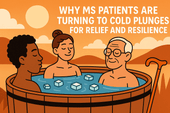
Why MS Patients Are Turning to Cold Plunges for Relief and Resilience
Cold plunges are no longer just for elite athletes and wellness influencers. A growing number of people with multiple sclerosis (MS) are turning to cold water immersion to ease symptoms, build nervous system resilience, and find calm in the chaos of chronic illness. This article explores why—and how—you might want to give it a try.
-
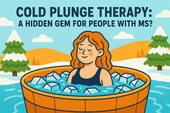
Cold Plunge Therapy: A Hidden Gem for People with MS?
Cold plunge therapy—once the domain of elite athletes and biohackers—is gaining attention among people with multiple sclerosis (MS). Could it help reduce inflammation, calm the nervous system, and ease MS symptoms like fatigue and spasticity? In this article, we dive deep into the science, benefits, safety, and practical application of cold plunges for MS recovery and symptom relief.
-
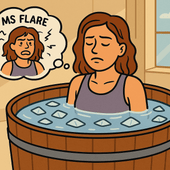
Finding Relief in the Midst of a Flare
MS flares can leave you feeling overwhelmed, exhausted, and mentally foggy. Cold water therapy is emerging as a promising tool to help reset the body and mind after a flare. This article explores how cold exposure supports recovery, calms the nervous system, and can be safely added to your daily routine.
-
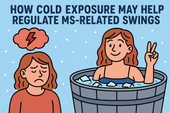
How Cold Exposure May Help Regulate MS-Related Mood Swings
Mood swings in multiple sclerosis (MS) can feel like emotional whiplash—one moment calm, the next overwhelmed, angry, or hopeless. While medications and therapy help, many people with MS are exploring natural strategies to support emotional balance. One surprising tool gaining attention? Cold exposure. In this article, we explore how cold plunges and other forms of cold therapy may regulate the nervous system, stabilize mood, and offer emotional relief for people with MS.
-
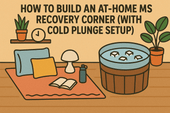
How to Build an At-Home MS Recovery Corner (with Cold Plunge Setup)
Create your personal MS recovery oasis at home—complete with a cold plunge setup. Learn how to design a space that supports healing, reduces inflammation, and helps you manage symptoms naturally.
-
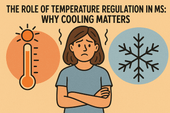
The Role of Temperature Regulation in MS: Why Cooling Matters

















































